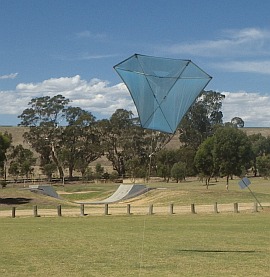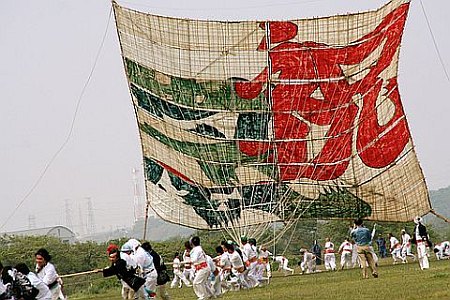- Home Page
- Kite Plans
- Scaling Sparred Kites
Scaling Sparred Kites
How Big Can You Go?
More than a couple of reasons result in people scaling sparred kites.
 The MBK Multi-Dowel Barn Door,
The MBK Multi-Dowel Barn Door,a 2.4 meter (8 foot) span oak-dowel kite.
It often happens. Someone sees a plan somewhere and gets enthused. However, they'd like a bigger kite to fly. Or perhaps the plans call for the spar material in a particular length and only a shorter length is available! This often happens with dowel or bamboo.
But this article is about what happens when you explore the upper limits of sheer size, particularly when building with simple rods as spars.
Bigger is better for most serious kite fliers. But the biggest successful kites that use just a few spars are nowhere near as big as inflatable show kites, which now have dimensions in the 10s of meters!
Interestingly, those massive show kites also have their theoretical limits, but that's another story entirely. Ask the guy whose surname rhymes with Flynn. ;-)
On this site, there's more kite-making info than you can poke a stick at. :-)
Want to know the most convenient way of using it all?
The Big MBK E-book Bundle is a collection of downloads—printable PDF files which provide step-by-step instructions for many kites large and small.
That's every kite in every MBK series.
The Weight Ceiling
I'd say the beating heart of this whole article is a certain scaling principle—a principle that limits the size of simple sparred kites. I have been aware of this for some time now, but only recently bumped into its implications with an actual failure of design. :-( There's more on that ill-fated kite a bit later.
You see, among others, two things happen when you simply scale up every dimension of a simple rod-sparred kite. Sail area goes up, but spar weight goes up even more!
The effect is very obvious when you do a little thought experiment with a two-stick diamond, where the sticks are square in section rather than round. What happens when you double every measurement?
- The sail area goes up by a factor of four.
- The cross-section area of the sticks also goes up by a factor of four, making them four times as heavy (per unit length). So far so good, with area and weight in sync. :-) But hang on...
- On top of that, the lengths (and hence the weight) of the sticks go up by a factor of two. So wing loading (weight divided by area) doesn't stay the same. It doubles!
Obviously, there's a pretty sharp limit to the sheer size of a rod-sparred kite. At some point, simply scaling up results in so much weight that the kite loses stability because of all that inertia. Also, eventually, the structure can't even lift its own weight. Try thinner spars? Nope, they'll bend like cooked spaghetti! More bridle lines? Perhaps, up to a point. But the limit just gets shifted along and not very far!
At this writing (mid 2020), my own efforts at scaling sparred kites has concluded with the Multi-Dowel series of designs. It seems that there are hints of that weight ceiling approaching, with these designs, since the series is based on 2.4 meter (8 foot) long dowel sections, plugged together. The diamond, delta, and rokkaku, although beautiful fliers in the right conditions, have somewhat limited wind ranges. The MBK Multi-Dowel Box, Barn Door, and Sled are better by virtue of differences in design type. They are just a little more tolerant of the scale effect on wing loading. However, if these kites were scaled up by another 50%, the results might be disappointing!
The Morbidly Obese Canard Kite
Recently, I really did bite off more than I could chew, with a failed massive canard kite. Through several changes, the 5.4-meter-span kite went from too floppy and weak to being too heavy to fly stable or climb far. On the way through, there was no sweet spot, unfortunately. :-| However, the experience did inspire me to try a new technique to extract more stiffness and less weight from a 100%-dowel frame.
Besides my own experience, this topic reminds me of an anecdote. I'm not sure where it was, but it concerned a keen flier and builder from decades ago. He had a large box kite design that was a great flier. So he made an even bigger one, to fly at events. Funny, it just didn't seem to fly as well as the smaller version, he wrote. You and me can probably hazard a guess as to what was the problem. :-)
Spar Materials and Types
If you browse around this site a little, you will notice that I enjoyed seeing what was possible with dowel, plastic sheet, and other cheap and widely available materials. It's a challenge, but it's possible to build quite high performing and fairly large kites this way, by getting the spar diameters and bridling just right.
Besides, many of the people accessing this site either can't afford fancy kite-making materials, can't source them, or just want a simpler and easier kite-building experience.
By now, you've probably thought what about better spar materials? Yes, that certainly ups the size limit on sparred kites considerably. Simply switching to carbon fiber or fiberglass will increase the strength-to-weight ratio.
But of course, any kite with a simple frame made from rods will have to bump into that weight limit somewhere, regardless of material.
How about tubes? Yes—using well chosen tubes busts through the limit yet again, since tubes offer greatly improved stiffness versus weight. This applies up to a point, of course. The limit is still there; it's just somewhat higher. So it's possible to build successful tubed kites that are very much larger than the biggest successful rod-based ones.
Tapered tubes offer a further refinement, removing excess weight from out near the tips where much less strength is required.
The Lattice Solution
 Kite lattice-work from Japan
Kite lattice-work from Japan Kite lattice-work from Guatamala
Kite lattice-work from GuatamalaBesides going from rods to tubes, what else can be done? Traditional kite-makers in Japan and Guatemala have found another solution to scaling sparred kites! A lattice-work of long light spars is supported in flight by many bridle attachment points. This approach allows a very large flying surface to get aloft. The two best examples I know of are:
- The giant rectangular kites of Japan, as displayed at the Sagami Giant Kite Festival each year.
- The giant circular kites of Guatemala, as displayed at the Day of the Dead Festival each year.
See the photos up there!
Trends With Size
Have you noticed a trend here? It's clear that with increasing size, viable sparred kites become more complex in form and/or construction. From rods to tubes to tapered tubes to lattices. When will someone go the final step and create an enormous lattice of tapered carbon tubes? Mind you, such a craft would be horrendously expensive. But at least they could break the record for the largest flying sparred kite!
A similar trend can be seen in aircraft wings:
- paper planes (flat surfaces only)
- hang gliders (curved single surfaces with tube spars)
- sport or general aviation aircraft (curved, double surfaces with internal ribs and I-beam or box spars)
- large airliners (compound wing shapes with very complex internal supporting structures)
Aerodynamic efficiency also increases with size. However, that doesn't count for much if the airframe is way too heavy! So a big kite should fly better than a scaled-down version, provided the weight/area ratio can be kept the same. That can take some doing!
Scaling Sparred Kites in Steps
If you want to up your favorite sparred kite to a massive size, going with a simple rod-based frame probably won't work too well. The end result will be either too heavy or too flexible. Fixing one aspect will wreck the other! Get there in steps, figuring out how to minimize weight and maximize stiffness further each time. Say goodbye to simple solid rods, unless you want to play around with the lattice idea, which works best with simple sail shapes such as circles or rectangles.
Still with me? I hope you enjoyed those thoughts on scaling sparred kites!
As mentioned earlier, there's more kite making on this site than you can poke a stick at. :-)
Want to know the most convenient way of using it all?
The Big MBK E-book Bundle is a collection of downloads—printable PDF files which provide step-by-step instructions for many kites large and small.
That's every kite in every MBK series.
